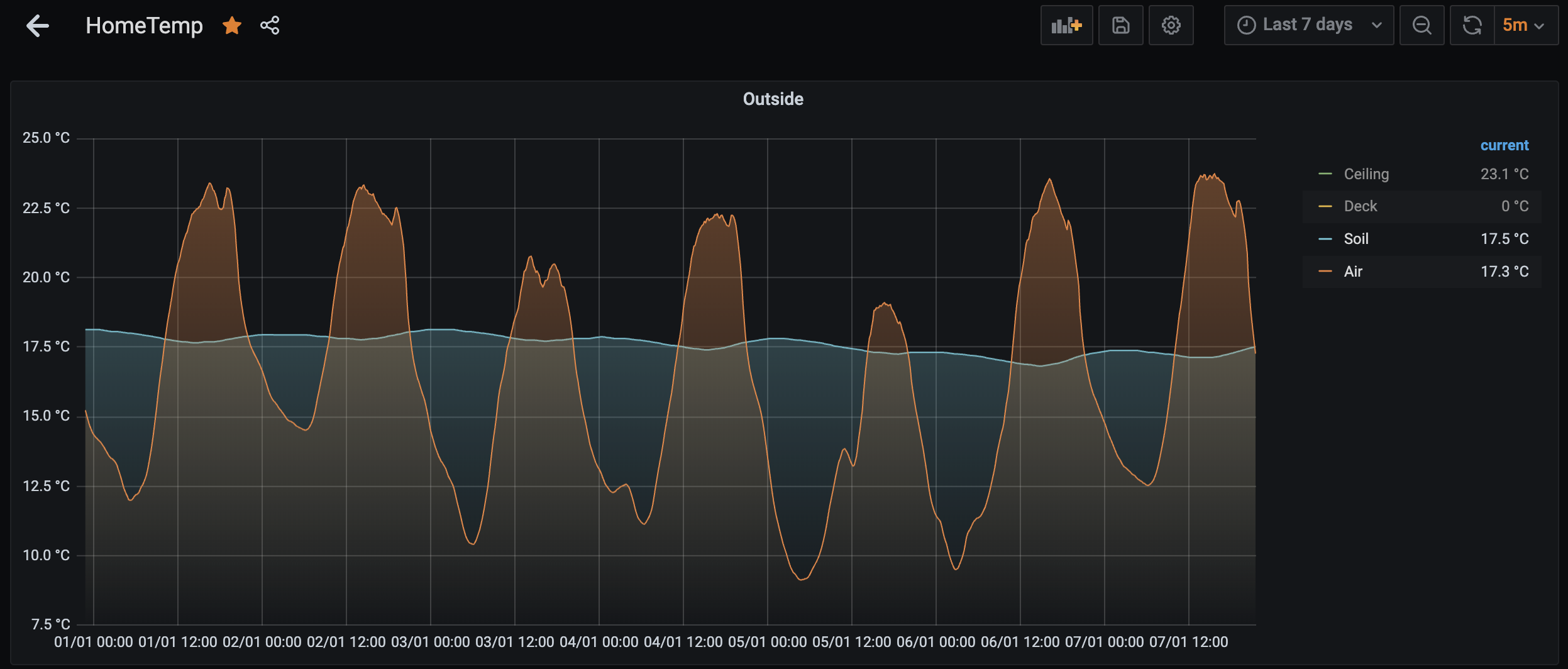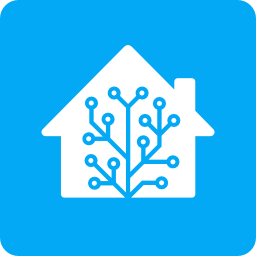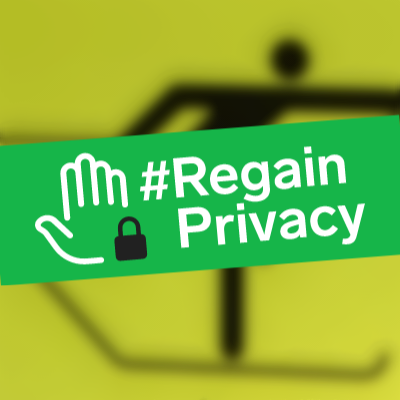I’ve been using HA for a while; having my home just “do things” for me without asking is fantastic. My lights turn on to exactly the levels I want when I enter a room, my grass and my plants get watered automatically, heating and cooling happens only when it needs to. There are lots of benefits. Plus, it’s just a fun hobby.
One thing I didn’t expect, though, is all the interesting things you can learn when you have sensors monitoring different aspects of you home or the environment.
- I can always tell when someone is playing games or streaming video (provided they’re transcoding the video) from one of my servers. There’s a very significant spike in temperature in my server room, not to mention the increased power draw.
- I have mmWave sensors in an out-building that randomly trigger at night, even though there’s nobody there. Mice, maybe?
- Outdoor temperatures always go up when it’s raining. It’s always felt this way, but now it’s confirmed.
- My electrical system always drops in voltage around 8AM. Power usage in my house remains constant, so maybe more demand on the grid when people are getting ready for work?
- I have a few different animals that like to visit my property. They set off my motion sensors, and my cameras catch them on video. Sometimes I give them names.
- A single person is enough to raise the temperature in an enclosed room. Spikes in temperature and humidity correspond with motion sensors being triggered.
- Watering a lawn takes a lot more water than you might expect. I didn’t realize just how much until I saw exactly how many gallons I was using. Fortunately, I irrigate with stored rain water, but it would make me think twice about wasting city water to maintain a lawn.
- Traditional tank-style water heaters waste a lot of heat. My utility closet with my water heater is always several degrees hotter than the surrounding space.
What have you discovered as a result of your home automation? While the things I mentioned might not be particular useful, they’re definitely interesting, at least to me.
Regarding temperature change when it rains, might it be logical to think air with more humidity has more capacity to store energy (and pull energy) than dry air, which is why it’s usually when it’s humid than when it’s clear sky (firing winter at least) and also can feel colder than it actually measures on a dry thermometer?
Tell me more about automatically watering plants
I have a Rachio irrigation controller. I’d recommend OpenSprinkler to avoid being tied to a “cloud” service, but I didn’t know that when I purchased my Rachio.
One of my irrigation zones feeds into my greenhouse. It splits off to two solenoid valves. When it’s time to water my plants, HA triggers that zone through the Rachio integration and opens the appropriate solenoid valve that connects to my emitters. If my humidifier gets low, then it does the same thing but opens the other valve.
The biggest one was probably a combo of having an anemometer, and heat/humidity sensors in each room.
When it’s cold outside, the top floor of the house (loft conversion) loses more heat. But it loses significantly more heat when it’s cold, and the wind is blowing parallel to the floor joists.
I realised that because they’re not perfectly sealed (old house), enough air pressure means that the floor void can easily hit external temperatures, meaning the rooms have cold on twice as many sides.
I will (eventually) get some suitable insulation in them to stop this.
While not publishing it, my weather station uploads my indoor temperatures to weather underground. The plaintext password is in every packet. It uses unencrypted HTTP.
My TV continues to chatter to random servers on the internet long after it has turned off. It transmits to a telemetry server on every single button press.
My air conditioners drain a lot more power when I haven’t cleaned the filters. It’s almost double.
A chromecast will try to bypass your router’s DNS and go straight to Google’s. It is constantly pulling data even if you’re not using it. I’m fairly certain it’s that slideshow. It’s not cached at all.
My TV continues to chatter to random servers on the internet long after it has turned off. It transmits to a telemetry server on every single button press.
What’s even more irritating to me are the random changes to the TV’s UI. Turn it off for a while and I come back to an entire new set of menu entries and ads!
Home Assistant, OpenWRT and Adguard Home mostly fix those problems.
When my TVs are powered off a Home Assistant automation enables a couple of OpenWRT firewall rules. Those rules block all TV Internet access. When the TVs are powered on the firewall rules are automatically disabled and the TVs work normally. That along with Adguard Home’s blocking of all UI ads makes my TVs almost user friendly.
Couldn’t you achieve the same effect by just having a PiHole?
Adguard Home is a Pi-Hole competitor. They work fine for ad servers, but the content I was trying to reduce couldn’t be blocked that way or the TV’s wouldn’t work. Menu changes were being loaded while the set was off and Roku was inserting some ad content along with menu changes.
To my surprise this setup has reduced menu additions and ads to almost nothing. It seems that these menus aren’t updated when my TV’s are actually in use and that’s now the only time they can connect to the Internet.
That’s a neat rule. Thanks for sharing!
@pHr34kY @corroded Not from home automation but from my #pihole installation.
My internet radio tries to send the title of each new song to itunes.apple.com. My smartphone tries to report any new installation / update of SW packages to googletagmanager.com.
Those are among the reasons I use a #pihole in the first place.I just have BIND DNS, but I do capture all DNS traffic and re-route it through my own server. There’s an adblock list on it.
I even set up DoT so my phone uses it for DNS when I’m out of the house.
What’s DoT?
DNS over TLS. It’s encrypted in transit. It’s like DoH (DNS over HTTPS), but runs in its own dedicated port and isn’t a total protocol rewrite.
I can see if someone is on the toilet and having a Nr.2 by checking the power draw of the Japanese style toilet. (I also have a presence detector). I do not monitor the first part intentionally, though.
I unintentionally catched some birds eating on camera and that led to us installing a designated bird cam - in a 3D printed bird house. The AI model for identification is still in the works though - there aren’t any good European based ones available as open source so I still will need to work out my own.
I found out the kid is reading FAR more than thought and is using the PC far less than I thought. Sorry kiddo!
CO2 is going up far more than expected,yes. What I found more interesting, though, is the direct connection between the humidity and my sinus infections - I always get them if my room air gets to dry.
Cooking releases an ungodly amount of VOC and uses FAR more electric energy than I thought.
And: After two years of optimisation I can control the temperature in two very sun exposed rooms just by using the covers and a weather forecast extremely well. Means they are up to 4° colder in the summer than before and 10° warmer in winter. Sadly this does not apply to all rooms.
And last but not least: Heating is the only point where home automation really saves energy here.
I had a terrible run of sinus infections last year so I’ve been using a humidifier and been checking the humidity in the house daily this winter. What percent range do you find is ideal?
I try not to go below 47%
Did you try BirdNET Pi?
Was going to suggest this - I’ve not used it myself but friends have and the model apparently does have fairly good results https://github.com/kahst/BirdNET-Analyzer
You know what, I’ve just checked and birdNET app is the one I use in the field, I thought I was using something from eBird. BirdNET is great for UK birds, I use it all the time! I’m an ecologist doing bird-stuff
Bird-net pi also runs here,but it provides audio identification,not optical identification.
Do you have induction hobs or traditional electric?
Induction
Huh, I figured induction would be cheaper.
I have no comparison to conventional electric - it might still be cheaper with induction. But I use induction for 10 years now, exclusively (and had gas before that).
But it’s the general cooking as well. Two ovens (One with steam,one conventional,of course not always used together,but it happens), other kitchen stuff, it is fairly interesting how big the peaks are that are created this way. And don’t get me wrong - our kitchen is kind of a upper market one in terms of appliances (the wood on the other side is run off the mill and was dirt cheap),but it’s also the thing that brings my family daily joy and I am more than happy to pay the power bill - but nevertheless I am still surprised.
Probably the most surprising thing I discovered with Home Assistant was the amount of electricity used by our washing machine in the supplied one in our rental. I hooked up a Kuaf Energy monitoring plug (PLF12) and was able to track each cycle by measuring the power draw. Something like this:
Fill 6.00 - 7.00 W Wash 493.5 -788.5W Drain 405-450W Spin 8.0 8.84 A + 498-800W
These are my rough notes and observations, I’m planning on creating an automation to indicate on our dashboard the current state of the washer making it a tad smarter. :) Also to alert us that it’s finished!
The other one I discovered was the amount of energy the Dishwasher pulls. . It’s a complex power draw and I’ve only managed to get our dashboard to show it’s running successfully. There is a huge variance in the power draws, that sometimes, I found that if it jumped by a volt or two, it would falsely say it’s in the second rinse cycle when it’s really filling the basin. Nonetheless, it was surprising to see how much less energy I thought the were using was.
I put a 4-1 one Zooz sensor up above the hall pointing at our front door, so it captures every entry point into our upstairs apartment. When I first set it up, it was a bit unsettling to have it detect even the smallest movement, eventually some adjustments were made and it’s more refined and not so trigger happy.
The biggest metric I discovered is just how humid our place gets! As a direct result, I bought a dehumidifier which we run year round. Living in the Pacific NW makes managing humidity challenging. (You know the old jokes about it being rainy all the time, yeah…it sort of is) As a result, we have a dehumidifier which runs year round almost non-stop. Not so much in the summer months. While most people buy a humidifier for the winter, we run it more in the winter as it’s too cold to exchange the outside air with the in which can lower it down to as low as 10-15% in the summer. We learned our comfort levels to be around 45-50% instead of the 75-80% it was before we bought the dehumidifier.
We are planning on relocating sometime this year to the other end of our state which is a different climate, so it will be a new discovery period of temps and humidity for us, for this, Home Assistant will be coming along for the ride! :)
Outdoor temperatures always go up when it’s raining.
Are you saying the outside weather temperature rises when it starts to rain, or am I understanding that incorrectly?
Depending on the location, but
- Often rain comes along for the ride on a warm front as it moves over the property (although cold fronts also carry rain)
- In winter, the rainclouds act as insulation and so rainy days are warmer than blue-sky days
It’s probably rain clouds trapping heat from escaping into the atmosphere, and humid air equalizing the temp by sucking heat off of high heat capacity surfaces like rocks and cement, warming the air.
That’s just my guess though. I have no relevant scientific expertise.
Along a similar line, ground temp (~200mm deep) lags air temps by about 12 hours

The humidity in my apartment is affected far more by cooking than by showering.
Is it the food or just that your extractor fan is bringing in outside air? (Please tell me you cook with an extractor fan!)
Many many places (it is a trend now) just have extractor fans that simply run through a shitty filter and blow it back into the room. My old rented house (it was just renovated in 2021) was like that along with tons of moisture problems coming from a half-assed renovation (turns out, the church officials were embezzeling a ton of money from the church company that came out a few years later) of a protected monument house from the 1500s.
Some apartments can have a charcoal filter hood instead of a fan that extracts directly to the outside, depending on ventilation design. My fan is one of those.
I don’t have a fan, but I have a window near my stove. HA’s graphs let me compare the effect of opening the kitchen window by itself vs opening it while cooking, so I can isolate the effects.
Are you cooking on gas?
You might recall that
carbohydrateshydrocarbons being burned release a lot of H2O.IME, the humidity from cooking is much much less when using an induction stove
No, induction.
I haven’t tried to differentiate between cooking involving boiling, steaming, etc. versus sautéing, frying, or other oil-based methods—I assumed the humidity spike was due to the former.
Hydrocarbons. Carbohydrates are in bread, pasta and potatoes.
Oven full of carbohydrates = good
Oven full of hydrocarbons = bad
By recording the electricity use in my house I noticed a 1500 watt spike at a semi-regular interval. It would happen every 50 minutes and lasted for a few minutes. While overall not that much of a draw, it sort of drove me crazy not knowing what it was…
Then I discovered that it was our septic system’s effluent pump (the leach field is up on a hill). The pump was turning on way too often because ground water was leaking into the pump chamber. It’s not supposed to do that. The tank was about 45 years old, so not a huge surprise really.
Basically, my home automation (or tracking, really) lead to an $8k concrete tank replacement (more or less, as we had the guy do some additional stuff while he was here).
That’s not really a bad thing though. Maintaining your house is very important. Our well had failed a coliform test the previous year, and I’ve yet to get it re-tested to see if the new tank fixed that little problem. I’ve been giving everything some time to settle down.
I learned my air filter uses almost no electricity so I just leave it running 24/7 now.
Minor and obvious thing, but seeing it plotted finally made me recognize it: the temperature on my balcony is consistently lower than temperature inside my fridge for a good part of the year.
My office electric space heater, on low, uses more energy than our pellet stove.
My server (and network gear) also use slightly more energy than the pellet stove.
The pellet stove’s energy usage does not seem to be drastically affected by the setting it’s on - this winter I’ve been keeping it on setting 2 (of 5), but the other day I ran it at 4 for a few hours. No distinguishable change in electricity usage during that time.
Wait, doesn’t a pellet stove produce heat by burning pellets? I’d figure the electricity use would be similar to a gas furnace, where it’s just running sensors and cycling it on or off.
Don’t you have to buy pellets and maybe even load them into the stove, depending on what kind of delivery system/hopper your stove uses?
Yes to all of that, except for the comparison to the gas furnace: I don’t know how much electricity they use (I know some, because our previous house had one, but it’s not a ton - electronics, igniter, and blower fan).
Yes, I do have to buy pellets and load them into the stove; I like to say the stove warms me up multiple times: Loading the pellets into our pickup, unloading them and stacking them in the garage, moving the bags from the garage to the stove (okay, this is not that hard and doesn’t warm me very much), and then when the pellets finally get burned. They’re 40 lb bags, not terrible but some work to move. (On reddit, at this point, I’m sure someone would jump in and call me a wimp or whatever, but having stacked a ton of them alone multiple times, it definitely adds up.)
The stove has two motors in it, I believe: an auger to lift the pellets from the hopper and drop them into the burn pot, and a blower fan for the draft for the fire. There may be a third fan to circulate warm air across the heat exchanger tubes as well, but I don’t remember for certain. There’s also an electronic board to control on/off, heat level, when to run the auger, etc.
My comment above was noticing that the power it consumes isn’t very different on different levels - which isn’t surprising, the fan runs a bit faster and the auger has to turn a bit more often, but it wasn’t an obvious difference over a few hours. I have it on a power monitoring plug to detect if it’s running (for automations like turning on a ceiling fan to help circulate the warm air, and keeping track of run time so I know when I need to clean it). I’ll have to test different levels to see if I can find a way to detect which level it’s set on.
Ah I see what you mean, my mind interpreted what you were implying in a completely different direction from what you intended.
Which makes me realize I had missed on a big part of home automation by not realizing you don’t need to have direct communication with the appliances for an automated home.
I need to look in to smart water flow meters and maybe I’ll be able to implement one thing that’s been kinda a pain here: needing to manually check the water softener level to tell if I should cycle it before running the dishwasher or washing machine. I also need to move things to get into the utility closet, so it’s a pain. Instead I could measure the flow to know how much is left and reset it when the softener draws more power for its regen cycle. And then have something check it and send an alert any time either of those water using appliances draw more power than idle if soft water available is less than a threshold.
Also, for your problem, I’m assuming now that the intention is to turn up the ceiling fan if the stove is at a higher level? Or something to do with circulating air based on that? If so, what about using temperature sensors and the difference between them? I think that would end up being more efficient and effective than just going by the stove setting, since you don’t need high fan as the stove warms up and might still want the fan going after it shuts down.
Or if you want to know for some other reason (pellet use tracking?), you could combine temperate differential with current fan settings and calculate a rough estimate of how much thermal energy it’s putting out.
The fan just turns on low when the pellet stove is running, nothing so fancy as changing the speeds based on the stove setting. But that could be accomplished indirectly by just looking at the temperature in the area - if it’s a few degrees higher than, say, the living room, turn up the fan speed.
In an ideal world I’d be able to control the setting on the stove remotely - there’s a button to change the setting, which a switchbot could theoretically do. Of course to do that reliably, HA should know what the current setting is. I haven’t really looked into this much.
But, yeah, I do wish I had a way to track the pellet level to alert me when it’s getting low. I have a Salt Sentry to monitor the salt in the water softener, with a gauge in HA, and it warns me when it’s getting low. Which is great (when it works, sometimes it stops responding). I’m not sure if it would work as well for the pellets - the pellets would be right up against the sensor when it’s full. Another option might be a weight sensor under a leg - I have no idea if this is even feasible, but if is, it should be able to detect the 40 lbs change (noting that there’s some ash left in the stove, so the 40 lbs doesn’t completely disappear).
I use the power monitoring plug for a lamp in the living room that is dumb, but it has a 433 mhz remote. The power monitoring detects whether it is on or not. I have one of those Sonoff 433 mhz transmitters, so with the power monitoring plug I can control the light. This also means it can be part of my “vacation” mode where it perhaps turns on at some point in the evening, then turns back off. Also, it turns on when first connected to power, so I can do an automation that sends the “off” command at night if the house is in Vacation mode and the light is on.
I don’t really have it set up yet, but in theory the power monitoring plugs could warn me if the freezer stops working (or is running constantly), the sump pump stops working, etc. I have the power monitoring in place, but not the automations to detect issues.
My old Samsung printer can enter a state where it consumes ~100W without doing anything meaningful. It’s not obvious what is wrong, but without power monitoring I would have never realized this.
CO2 levels raise astonishingly fast when people are present in a room.
I have mice visiting my garage and I can tell when by looking at the motion sensor history.
My uninsulated roof stays frost free even at -15°C.
What type of printer? Maybe keeping the ink from going solid?
Maybe it’s keeping the roof frost free too…
Probably a laser printer, keeping warm to be ready to print as soon as it gets a job. My laser printer (also Samsung) draws nearly 1000w after a cold start.
If turned off after use, as in powered off, the laser printer first must go through a warm up cycle where it needs to heat up the fuser so it can “bake” or fuse the text/image to the printed page. This is where you see a tremendous power spike, and can often overload a battery backup if you have it connected with a computer as well.
I have a Dyson smart air purifier / heater combo in my room. It has a mostly real time app that shows whether the air is healthy or unhealthy. One night I was laying in bed and felt some gargantuan ass thunder brewing, so I aimed my cheeks toward the Dyson and watched gleefully as my air quality went from green to red. Technology is amazing.
Wait, how do you make your smart bulbs turn off and on automatically when you enter/leave a room? I’ve been using them for years and I always have to manually trigger them with an app! And how are you measuring power usage?
I use a mmWave presence sensor and PIR motion sensor in each room. I’ve found that mmWave sensors tend to give false positives and motion sensors don’t work too well when a person is at rest (say sitting and watching TV). Lights come on when the motion sensor triggers, then they shut off when the presence sensor has been idle for a set time, usually 5 minutes. This works perfectly for me.
I’m gonna assume you’re not using Home Assistant yet.
There is an app for Home Assistant but from your comment I’m assuming you’re talking about something like Smart Life.
Home Assistant takes all these different companies and creates a central hub for them all. So we have Hue bulbs and Nest cameras all talking to each other via Home Assistant.
If you’re already using Home Assistant then disregard and have look into PIR and Mm Wave sensor.
I’ve moved up a level and recently made a bed sensor.
- Motion sensors. The mmWave are very sensitive but also expensive. Nice for rooms where you sit still or lie down for longer periods, such as an office or bed room. PIR sensors are the cheap ones, very useful for hallways, stairs, kitchen and toilets.
- Some smart plugs measure current. Innr has a nice zigbee smart plug with a physical button and monitoring for around €20.
FYI If you have a Zigbee bridge, you can just connect most zigbee devices to it and you are not tied to the app or devices of the bridge’s brand.
You’ll want to research “room presence” systems.
Here’s one I’ve been looking at implementing for an example: https://espresense.com/
If you go this route, you’ll absolutely need mmWave sensors as regular PIR sensors only sense movement not presence and you’ll experience lights shutting off when you’re sitting too still in a room. I’ve considered setting this up a few times but want mmWave and PIR sensors with a lux sensor all-in-one and the market for this is extremely small. I think only some sketchy Tuya and the Everything Smart Home youtube channel have sensors like this but they’re expensive and I just haven’t pulled the trigger.













